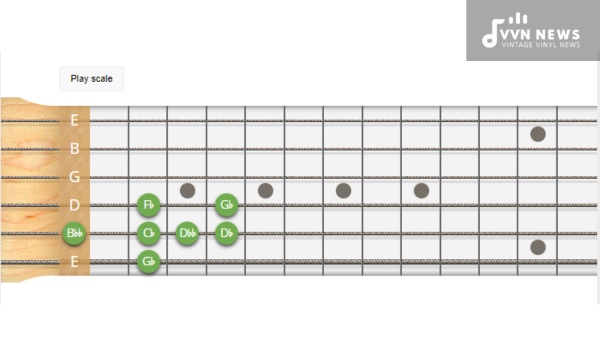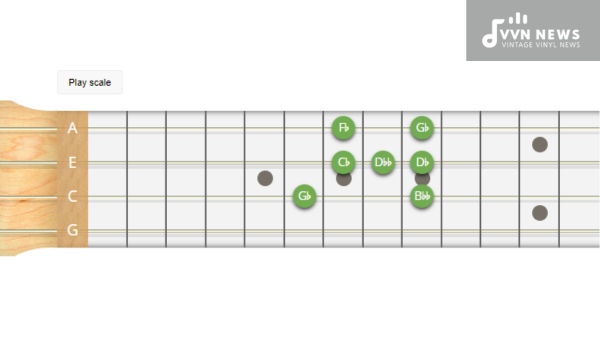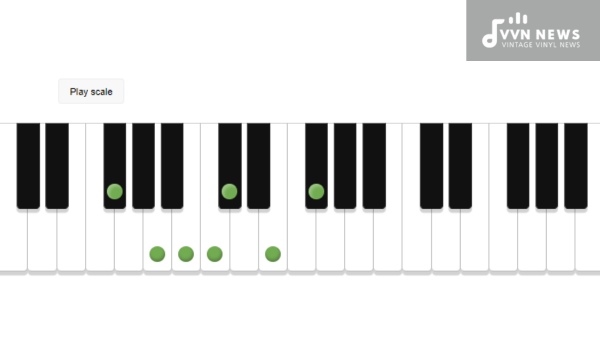Unlock the soulful essence of blues music by mastering the G flat minor blues scale, a rich tapestry of notes that can add layers of emotion and depth to your playing.
Whether you’re a seasoned guitarist or just starting your musical journey, understanding this scale is crucial for anyone looking to inject their blues with an authentic, heartfelt sound.
I’m here to guide you through the nuances of the G flat minor blues scale and provide you with the knowledge needed to bring out its full expressive potential in your performances.
Navigating through the G flat minor blues scale might seem daunting at first, but fear not, as it’s comprised of a relatively simple structure that’s both versatile and deeply evocative.
In this article, we’re going to break down this iconic scale note-by-note and explore how each one contributes to the overall vibe of your blues playing.
You’ll discover how to incorporate these tones into your own music, creating solos that resonate with the raw emotional power synonymous with great blues artists.
Let’s get started on unlocking the secrets behind those soul-stirring melodies!
The Notes of the G Flat Minor Blues Scale
Embarking on our exploration of the G Flat Minor Blues Scale, we encounter a series of six distinct notes that form the core of its characteristic sound. This scale is built upon these essential pitches:
- G♭ – The root note, anchoring the scale with a profound tonal foundation.
- B♭♭ (A) – Known as the minor third, adding a heart-wrenching twist.
- C♭ – The fourth, which seamlessly bridges to a bluesy aura.
- C (also referenced as D♭♭) – The ‘blue note’, emanating a raw, emotive edge.
- D♭ – The perfect fifth brings balance and stability to our scale.
- E (or F♭) – Completing the octave, the minor seventh injects a dose of tension and resolution.
Each note plays an integral role, together weaving the melancholic tapestry that is synonymous with blues music’s soulful cries and lyrical depth.
Understanding their relational dynamics not only aids technical proficiency but expands your expressive palette when immersing yourself in the G flat minor blues landscape.
Also Read: A Sharp Minor Pentatonic Scale [Unique Harmonic Possibilities]
How do you build the G Flat Minor Blues Scale?

To construct the G Flat Minor Blues Scale, we begin with its relative minor pentatonic scale and add a chromatic blue note for added flavor.
The scale consists of six notes, following a specific 1 – 3 – 4 – ♭5 – 5 – 7 formula when compared to the major scale.
Here’s a step-by-step approach:
- Start with the root note, G♭.
- Move a minor third up to land on B♭.
- A whole step brings you to C♭ (or B), offering a perfect fourth.
- The blue note is a semitone higher at D♭, creating the diminished fifth.
- Another semitone ascent takes you to D♮, the perfect fifth.
- Lastly, skip a whole step to reach F♭ (or E), the minor seventh.
The sequence in notes: G♭ – B♭ – C♭(B) – D♭ – D♮ – F♭(E). This blend of intervals gives it that hauntingly distinctive blues sound that’s essential for moody blues improvisation and expression.
What’s the Difference Between G Flat Major and Minor Blues Scales?
When delving into blues scales, understanding the fundamental differences between major and minor variations is crucial.
Let’s explore how the G flat major and minor blues scales differ from one another.
G Flat Major Blues Scale:
The G flat major blues scale adds a bluesy flair to the traditional major pentatonic by incorporating an additional blue note. The result is a six-note scale that consists of:
- G flat (Root)
- A flat (Major 2nd)
- B flat (Minor 3rd) – Blue Note
- B (Major 3rd)
- D flat (Perfect 5th)
- E flat (Minor 7th)
This scale tends to have a brighter, more optimistic sound due to the presence of a major third interval from its root.
G Flat Minor Blues Scale:
On the flip side, the G flat minor blues scale is rooted in a more somber emotion, typical of what many associate with “the blues.” This scale is built using these notes:
- G flat (Root)
- A (Diminished 3rd)
- B (Diminished 5th) – Blue Note
- Cb (Enharmonic Equivalent of B) – Minor third
- D flat (Perfect fourth)
- E (Diminished seventh)
The distinguishing factor here lies in its blue note, creating tension that yearns for resolution—key to stirring up those classic, melancholic vibes.
By grasping these differences, you’re well-equipped to inject varying emotions into your music through adept scale choice—turning simple notes into profound stories told through your instrument.
Also Read: B Flat Minor Pentatonic Scale [Create Emotive Music In Minutes]
Why is Ear Training Important for Learning Scales in G Flat Minor Blues Scale?

Ear training is an essential component of mastering any musical scale, particularly when delving into the intricate world of blues.
Let’s explore the significance of ear training in the context of the G Flat Minor Blues Scale:
- Enhances Musical Understanding: Ear training sharpens your ability to recognize pitches, intervals, and patterns within the scale. This deeper comprehension allows you to internalize the sounds, making it easier to play the scale fluently and with emotion.
- Improves Improvisation Skills: A strong ear enables you to anticipate which notes will sound good together. In improvisation, where spontaneity reigns supreme, being able to quickly identify harmonious combinations within the G Flat Minor Blues Scale is invaluable.
- Facilitates Transcription: By developing your ear, you can effectively transcribe music by identifying scale patterns by sound alone. This skill can be particularly helpful when trying to learn songs that incorporate this emotionally charged scale.
- Assists in Jamming and Collaboration: When playing with others, ear training helps you lock in with fellow musicians. Being attuned to the nuances of the G Flat Minor Blues Scale ensures a more cohesive and dynamic group performance.
- Develops Relative Pitch: Through dedicated ear training, many musicians develop relative pitch—the ability to identify or sing a note by comparing it to a reference note—a vital skill for navigating through scales and creating music on-the-fly.
Investing time in ear training propels not just technical proficiency but also your overall musicianship.
As you grow more familiar with each tone in the G Flat Minor Blues Scale by ear, you’ll find yourself expressing thoughts and emotions through your instrument as naturally as speaking your native tongue.
Also Read: D Major: The Scales And Chords [Broaden Your Musical Vocabulary]
Songs Utilizing the G Flat Minor Blues Scale
When diving into blues music, you’ll find a treasure trove of songs that utilize the emotive power of the G flat minor blues scale.
Let’s explore some iconic tracks that harness this scale to create an enthralling musical experience:
- Stevie Ray Vaughan’s “Texas Flood”: A staple in the world of blues, Stevie Ray Vaughan masterfully employs the minor blues scale throughout this heartfelt performance, giving it its signature melancholic vibe.
- B.B. King’s “The Thrill Is Gone”: King’s use of the G flat minor blues scale underscores his dexterous creativity and expressive bending techniques, making this one of his most moving pieces.
- Gary Moore’s “Still Got The Blues”: Although often played in different keys, when performed in G flat minor, Moore’s profound guitar solos showcase how the blues scale can be stretched to its expressive limits.
Each song is a testament to the profound impact that just a handful of notes can have on music listeners worldwide.
They demonstrate not only technical prowess but also a deep understanding of how to convey emotion through melody and rhythm.
Also Read: B Major: The Scale And Chords [Guide To This Bold & Beautiful Key]
FAQs About The G Flat Minor Blues Scale
What exactly is the G Flat Minor Blues Scale?
The G Flat Minor Blues Scale is a six-note scale that adds a bluesy feel to your music and typically includes the intervals 1, ♭3, 4, ♭5, 5, and ♭7 from the G flat minor scale.
Can you list the notes in the G Flat Minor Blues Scale?
Yes, the notes are G♭, B♭♭ (A), C♭ (B), C (B♯), D♭ (C♯), and F♭ (E).
Is the G Flat Minor Blues Scale suitable for beginners?
Absolutely! Despite its complex sound, this scale is approachable for beginners who are eager to add an expressive edge to their playing.
How does playing in G Flat affect my choice of instruments?
Playing in G Flat might require instruments that can comfortably handle flat keys or those which can be easily tuned to accommodate such scales.
Where can I find resources to practice the G Flat Minor Blues Scale?
There are various online platforms offering backing tracks and tutorials; look for ones that specifically cater to blues music e.g., YouTube tutorials or dedicated blues websites.
Conclusion
In the end, as you dive into the depths of the G flat minor blues scale, remember that it’s not just about memorizing a sequence of notes, but understanding how they interplay to create emotional resonance.
Whether you’re bending a string to hit that perfect blue note or flowing seamlessly between scales, practicing with a backing track will hone your skills.
Don’t forget, developing an ear for these nuances is as crucial as learning the scale itself.
By embracing every note and its role in crafting soulful blues melodies, you are unlocking new avenues for musical expression.








